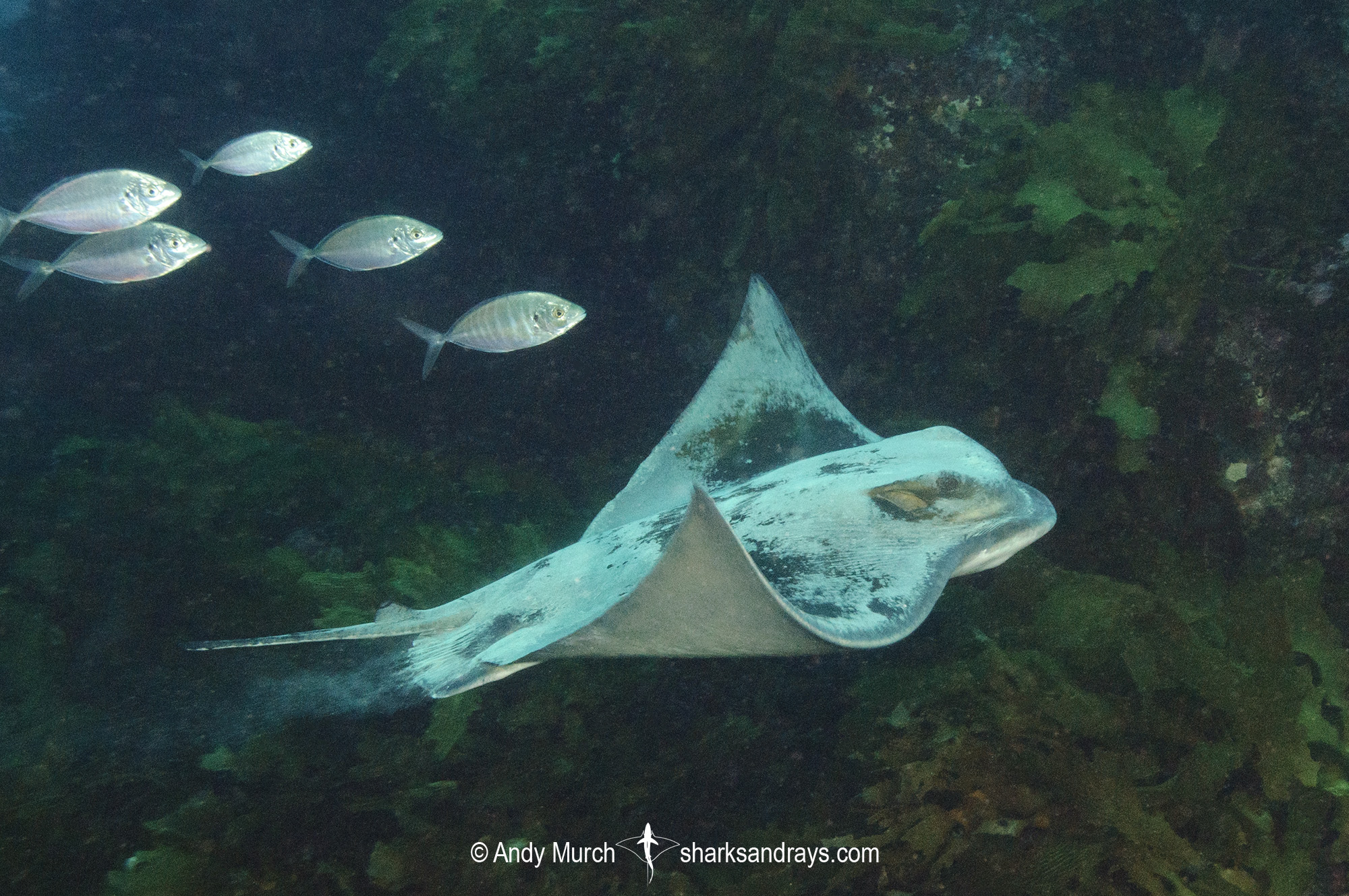Common name(s)
Southern Eagle Ray, New Zealand Eagle Ray, Australian Eagle Ray, Bull Ray.
Identification
A large eagle ray with a wide kite-shaped disc and large protruding head. Disc width 1.6-1.8 x length. Rostral lobe short, fleshy, broadly rounded, joining pectoral fins below eyes. Spiracles large, positioned laterally, barely visible from above. Nasal curtain short and wide with a long fringe along posterior margin, without deep central notch.
Pectoral fins have mildly convex anterior margins, concave posterior margins, tightly rounded apices, angular free rear tips. Pectoral fin origins below eyes. Disc entirely smooth, lacking denticles or thorns. Pelvic fins large, extending beyond disc margin. One small dorsal fin with a broadly rounded apex and a short free rear tip, positioned midway between tail base and caudal sting. Tail broad based and long, tapering abruptly to caudal sting then filamentous to tip. Tail length more than 1.3-1.7 x disc width when intact. 1-3 caudal stings usually present.
Colour
Dorsum yellowish-brown to olive grey, with subtle irregular blue spots, blotches and vague bands. Ventrum white with dusky or dark pectoral apices.
Size
Maximum disc width 160cm. Disc width at birth 20-30cm.
Habitat
Tropical to temperate seas. Shallow sandy bays, estuaries, sea grass beds, tidal flats, and deeper water. Intertidal to at least 422m but usually in less than 50m.
Distribution
Southeast Indian Ocean and southwest Pacific. Southern Australia, New Zealand, Norfolk Island and the Kermadec Islands.
Conservation Status
LEAST CONCERN
Around New Zealand, the southern eagle ray is mainly taken as bycatch in inshore trawl fisheries around the upper North Island and it is usually discarded. It is also taken in harbour set net fisheries, as well as a variety of other fisheries. In some fisheries, it is increasingly being retained for its meat (C. Duffy, pers. comm. 07/10/2015). Reported catches (including discards and live releases) have been increasing in New Zealand from 55 tonnes in 2004-05 to 108 tonne in 2011-12 (MPI 2013).
In Australia, it is taken as a bycatch in the Southern and Eastern Scalefish and Shark Fishery with an estimated annual catch of 88 tonnes between 1998 and 2006, of which 55% was retained (Walker and Gason 2007) as well as in other local coastal fisheries.
This species probably survives capture and release well. A small number of eagle rays are caught for exhibition in public aquaria.
Citation
Kyne, P.M. 2016. Myliobatis tenuicaudatus. The IUCN Red List of Threatened Species 2016: e.T70686656A70687032. https://dx.doi.org/10.2305/IUCN.UK.2016-1.RLTS.T70686656A70687032.en. Downloaded on 06 March 2021.
Reproduction
Matrotrophic viviparity. 2-20 pups per litter (average 6).
Diet
The southern eagle ray consumes a wide variety of invertebrates including gastropods, bivalves, crustaceans, and polychaete worms.
Behavior
Adults migrate southward during the warmer summer months. When feeding, southern eagle rays excavate large pits to reach buried sessile prey; an important contribution to the health of inshore ecosystems.
Reaction to divers
Often shy around scuba divers unless preoccupied with feeding, or habituated.
Diving logistics
An easy species to encounter throughout much of its range.
Southern Eagle Rays are extremely common around the north island of New Zealand. A good spot is the Tauranga/Bay of Plenty area. Any shallow shore dive should turn up a few although they come and go (Intel. Helen Cadwallader).
In Australia, they are fed by tourists and fishermen cleaning their catches at numerous spots including Hamelin Bay in Western Australia and Bendalong in NSW. At Hamelin Bay it is possible to walk off the beach with snorkel and fins and swim with rays as they move in and out from the beach. The area also attracts enormous short-tail rays.
What’s new
View our full list of updates
Similar species
Banded Eagle Ray Distinguished by narrower rostral lobe that does not attach to pectoral fins, more obvious blue bands across disc, and more northerly range within Australia.
Purple Eagle Ray Distinguished by uniformly purplish-brown to olive-brown dorsum. Only sympatric at the southern extent of its range.




